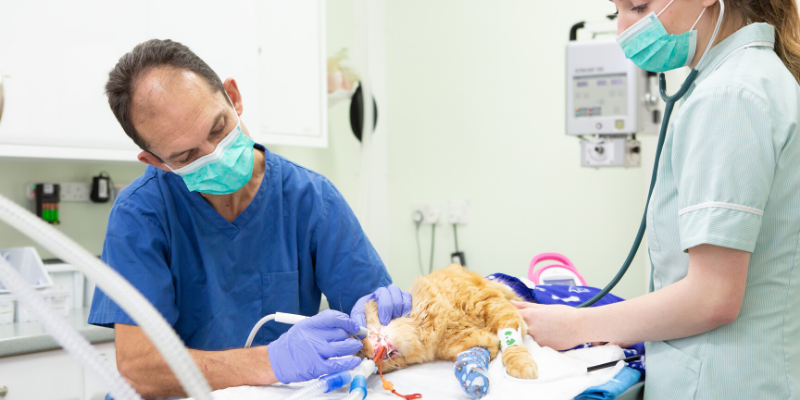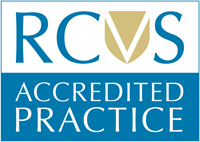What is general anaesthesia?
General anaesthesia (GA) is a loss of consciousness and sensation. This enables us to perform procedures on our patients without them feeling pain or moving around.
There are three aims that we have for each general anaesthetic:
- Unconsciousness
- Muscle relaxation
- Pain relief (analgesia)
By inducing these safely, we can then perform the required medical procedure on your pet.
What is a premedication?
A premedication is often a combination of drugs used to help relax the patient and reduce anxiety prior to the GA. A strong pain relief medication and a sedative is a common combination. It is normally administered into the muscle via an injection.
Aims of premedication:
- Calm and quiet the patient
- Reduce the amount of anaesthetic drug used
- Facilitate handling and improve safety
- Contribute to a smooth recovery
- Pain relief
- Muscle relaxation
What is the role of a veterinary nurse in general anaesthesia?
A veterinary nurse undergoes three years of training to become qualified, with continuous study required to maintain their position as a registered veterinary nurse. Part of this training is specifically focussed on monitoring and providing balanced anaesthesia to our patients undergoing procedures. This is carried out under the direction of a veterinary surgeon, but is a very important part of keeping your pet safe under their anaesthetic – not only is someone solely focused on their anaesthesia, but the veterinary surgeon is able to concentrate on the procedure itself, knowing that they have a highly trained colleague monitoring your pet. It is considered best practice for procedures requiring general anaesthesia to be done in this way.
What do we need to know about the patient before anaesthesia?
It is important to gather a detailed previous history of the patient prior to the anaesthetic. This will reveal any pre–existing conditions and any ongoing medication that may affect the drugs that we administer. We also look at any previous allergies or reactions to drugs given before as we can give alternative drugs to prevent any further issues. This, together with information including their age, vital signs e.g. heart, respiration and blood pressure, clinical history and what procedure they are having carried out, allows the veterinary surgeon and veterinary nurse taking care of your pet create a tailored anaesthetic plan just for them, to ensure their comfort and safety.
What checks do we carry out before inducing (giving) the anaesthesia?
When your pet arrives, we carry out a thorough examination to check for any health issues that might increase the risk from an anaesthetic. All vital signs are checked including the heart rate and rhythm, breathing rate and pattern, mucous membrane colour and capillary refill time, blood pressure and temperature. We also check their hydration status and overall demeanour. This allows us to assess their health status before we proceed, and you would be notified if there were any concerns before we proceed with the procedure.
Why do we carry out a pre-anaesthetic blood test before administering any drugs?
We offer a pre-anaesthetic blood test to every patient, whether it be a young fit patient coming for a routine neuter or a geriatric patient with an underlying health condition. It means that organ function can be assessed prior to induction, giving us more information about their risk level under a general anaesthetic.
For young patients, it’s an opportunity to check your pets body systems are functioning effectively and that there are no underlying health conditions that have not shown any outward symptoms yet. It is also an opportunity to get a base line of what healthy looks like for them, so that we can monitor them more effectively as they get older.
For older patients (aged over eight years old), or patients with other health conditions, the pre-anaesthetic blood test is highly recommended. This is to check that there are no underlying conditions, for example liver disease, anaemia or kidney problems which are more likely to be seen in these patients, all of which might complicate an anaesthetic. This enables us to alter drug amounts and types if necessary and mitigate the anaesthetic risk with additional measures to keep them safe.
What do we do to keep our patients warm under anaesthetic?
After administering the premedication, the patient’s temperature can start to drop. We will look at the patient’s temperature when they arrive and decide whether they need heating aids prior to the anaesthetic to maintain normal temperature. Animals cannot maintain their temperature themselves under anaesthesia and are at risk of hypothermia, so we must help them to maintain a normal temperature. Hypothermia can cause the patient to have a prolonged recovery.
We usually use a veterinary-specific heat mat which lies under a blanket or towel to maintain body temperature. A drip warmer can also be used if the patients requires intravenous fluid therapy. This warms the fluid before it enters the body, helping to maintain their body temperature.
Materials like bubble wrap and specially made blankets are also used to prevent heat escaping from the body.
What are the risks involved with anaesthesia?
With any anaesthetic, there is always a risk due to the suppression of the central nervous system that takes place. Factors like, breed, age and health status play a huge role in identifying the risk of an anaesthetic or sedation.
Specific breeds like French Bulldogs, British Bulldogs and Pugs are at a higher risk of issues under general anaesthetic due to the formation of their skull and the airway, with the main issues occurring during recovery and intubation. These breeds are also known as brachycephalic breeds.
Why is it so important to starve patients for 12 hours before a general anaesthetic or sedation?
We ask that cats and dogs are starved for 12 hours prior to the procedure so that they don’t have a full stomach and aren’t at risk of vomiting or regurgitating. Whilst under the anaesthetic, patients don’t have control of their gag reflex, therefore, they are at risk of vomiting and that material going into the lungs, causing health issues. Young puppies and kittens are the exception to the rule, this will be discussed with you on an individual basis.
There is an exception to this rule with rabbits as they need to be fed up until the procedure. The reason being that their digestive system needs to keep moving otherwise they are at risk of gut stasis, a serious condition in rabbits. We also ask that ferrets are starved 1-4 hours prior to surgery.
What is the risk for our elderly patients?
Geriatric patients are considered higher risk under anaesthetic. There are a few factors to consider. The first being that their organs are not going to be functioning as efficiently as a younger patient. This means that drug metabolism is slower, and recovery is often longer. The second being that the length and severity of procedure, as this can determine whether we go ahead with the surgery or not. This length of the recovery period is important and whether the patient will cope, for example, an orthopaedic procedure.
Despite this, if a geriatric patient needs an anaesthetic for us to carry out a procedure, then we examine the risks versus quality of life. We must have the conversation of whether the procedure will improve quality of life and this outweighs the risks under general anaesthetic. Your vet will discuss this with you in detail, and will not recommend undertaking the procedure if the balance is tipped in the wrong direction.
Why do we sedate some patients and others go under general anaesthetic?
The decision to sedate or fully anaesthetise the patient is made depending on the procedure. Sedation is normally used for diagnostic imaging and minor procedures. A full anaesthetic is used for procedure where the patient is required to not move at all or if is a painful procedure.
Both methods are usually very safe in a healthy patient. However, sedation in brachycephalic breeds is a higher risk as the airway can’t be maintained with an endotracheal tube, so they are often recommended to have a full general anaesthetic instead. The decision is made based on the individual patient and with discussion with the owner.
How long does it take for a patient to recover from general anaesthetic or sedation?
The recovery of the patient depends on the procedure performed, drugs administered, age, health status and degree of anaesthetic used on the patient. The immediate recovery can take anywhere between 5 minutes and 2 hours. Patients are monitored constantly until they are moving around the kennel. The drugs used can take between 24 and 48 hours to be metabolised by the liver and kidneys, therefore, the patient can be quieter for a few days post procedure.
By carefully assessing the needs of each patient individually, assigning a veterinary surgeon and veterinary nurse to monitor them throughout the process and by taking additional steps to support your pet through their general anaesthetic, our team reduces the risks of anaesthetic for your pet, allowing us to carry out the required procedures.
Call us on 01435 864422 if you have any questions about anaesthesia and your pet.


